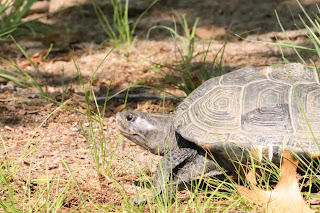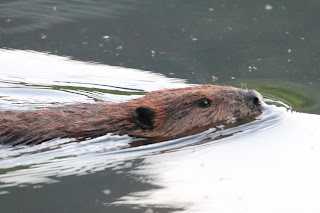As I've mentioned, birders keep lists. Some birders keep life lists, state lists, town lists, county lists, etc... I have a friend that kept a tree list because he had a seventy foot spruce in his front yard. As I've said a hundred times I am not keeping a year list anymore. However, I'm still willing to chase birds that are lifers or state birds for RI. Rhode Island is the only state I keep a life list for. This is because I do most of my birding in Rhode Island. Even though I've been to Florida a couple of times, I couldn't tell you how many species I've seen there. I only kept track of the species that I was interested in. Though I wrote down my lifer Roseate Spoonbill, and my White Ibis (not a lifer, I'd seen them in North Carolina first) I did not keep track of things like Blue Jays, Robins, or Cardinals.
All birders have a nemesis bird. This is a species that is difficult for them to find. The first year I did my Rhode Island Big Year my nemesis bird was Purple Finch. It was by far the easiest bird that I missed. I spent much of the winter checking out a crab apple orchard where they fuel up to keep warm. I went to places they breed during the early summer. I went to places they were seen during migration during the fall, and back to the crab apples the end of December. To make the salt burn even more, when the year was over, I saw them a few days into the following January!
Now that I am not keeping a year list, I have no such worry about seeing a Purple Finch. However, I still like to get state birds and lifers. Last year I missed out on some really cool birds because of my back. Birds like Gray Kingbird, Ross's Goose and MacGillvary's Warbler showed up. My back couldn't take the drives so I missed out.
By far the species that has been my biggest Rhode Island nemesis is the Royal Tern. I have yet to see one in Rhode Island. I have seen them in three other states (FL, NC, DE) but despite chasing them all of these years I still haven't seen one. The species always shows up when either I can't chase it, or if I do, it is gone before I get there. It tortures me.
Last year, while I was still working but my back was in pain, I decided not to go with my friends to the Charlestown mudflats. The mudflats are a meeting place for birders every Saturday form the beginning of July through Labor Day. I had every other Saturday off. This particular Sat was one in which I wasn't working, I just couldn't bring myself to make the long drive and then take my kayak off of the car and paddle. You can see where this is going, right? Well, yup, there was a Royal Tern at the flats. Of course, you can understand why I missed that bird.
But, there are so many crazy reasons I missed Royal Tern before last year, none worse than the following: A few years back I was at Napatree Point with my friends Sue and Jan. We walked around the lagoon to get to the rack of rotting seaweed on the other side. Rotting seaweed draws insects which draw in shorebirds. After looking at the birds it was time to leave. We had the choice to walk back around the lagoon or walk through the outflow. The outflow is probably twenty yards wide and between ankle and knee deep at low tide. I chose to walk through the outflow, but the ladies didn't want to get their feet wet so they went around. I sat down and waited for them taking photos of a friendly Plover that walked all around me. When they got back I hear "Did you see the Royal Tern? It flew by us" Obviously I did not see the Royal Tern. So I missed it because I wasn't afraid to get my feet wet.
Monday Barbara Seith saw Royal Terns at Quonny. Usually when they are reported it is pointless to chase them if you live far away. They usually only hang out for a few minutes and take off or they are a fly by anyway. I couldn't go chase them because Laurie and I had plans that day. Wouldn't you know it, the terns stayed there ALL DAY! They'd leave for a while but come back to the sandbar. It was so frustrating to see the reports.
Tuesday morning Barbara finds more terns. This time at Brenton Point. I didn't have plans with Laurie so I was off to see them as soon as I could. It is an hour and twenty minute ride to Brenton Point. I got there as quickly as I could but despite two hours of searching, the birds were no longer there. So I came back with my tail between my legs starting to hate this bird.
The analogy I said to Barbara was when I finally see one in Rhode Island it won't feel like a monkey off of my back. There will be no satisfaction. It will just feel as though I finished folding a load of laundry. Glad its over with but there is no joy in it. The difference is a load of laundry doesn't cost me thirty dollars in gas each time!
The photos of Royal Terns in this post are from Bowman Beach on Sanibel Island. Laurie, myself, and Sue Palmer went to the beach shelling. Besides getting some cool shells we saw dolphins just off the beach and terns. Both Royal and Sandwich Terns came in and let us take photos from 11.6 feet away (the distance my lens needs to focus)
























































